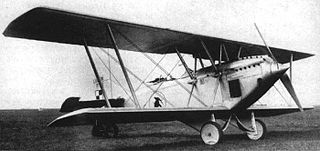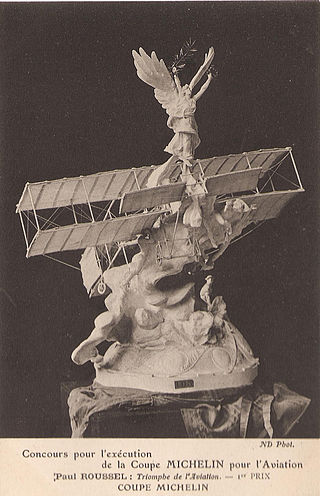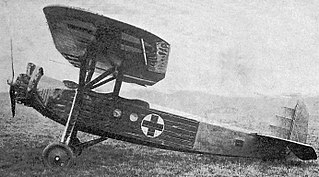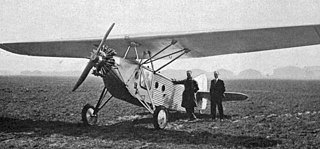
The Lublin R-VIII was a Polish bomber, reconnaissance aircraft and seaplane designed in the late 1920s by the Plage i Laśkiewicz factory in Lublin. It was the first in-house design of Plage i Laśkiewicz, and the first with the name Lublin.

The Percival Mew Gull was a British racing aircraft of the 1930s. It was a small, single-engine, single-seat, low-wing monoplane of wooden construction, normally powered by a six-cylinder de Havilland Gipsy Six piston engine. During its racing career it set many records and was considered a significant, efficient design, one that eventually reached a top speed of 265 mph (425 km/h) on a modest 205 hp (153 kW) in its final 1939 form. A modern-day observer has characterised the Mew Gull as "the Holy Grail of British air racing". During the second half of the 1930s, Mew Gulls were dominant in air-racing in the UK and consistently recorded the fastest times until the outbreak of war stopped all civilian flying in late 1939.

Aéroplanes Hanriot et Cie. or simply 'Hanriot' was a French aircraft manufacturer with roots going back to the beginning of aviation. Founded by René Hanriot in 1910 as The Monoplans Hanriot Company Ltd. the company survived in different forms until 1916 when it established itself with the Hanriot-Dupont (HD.) fighters and observation aircraft. The company lasted through several takeovers and structural changes until in 1936 it merged with Farman to become the Société Nationale de Constructions Aéronautiques du Centre (SNCAC). 'Central Air Works' consortium.

The Morane-Saulnier MS.230 aircraft was the main elementary trainer for the French Armée de l'Air throughout the 1930s. Almost all French pilots flying for the Armée de l'Air at the outbreak of World War II had had their earliest flight training in this machine. It was the equivalent of the Stearman trainer in the United States air services and the de Havilland Tiger Moth in the British Royal Air Force.

The Lorraine-Hanriot LH.10 was a family of training monoplanes built in France in the early 1930s, the most widely produced and well-known member of which was the LH.16, later known simply as the Hanriot H.16. It was a conventional parasol-wing monoplane with fixed tailskid undercarriage, the main units of which were mounted on outriggers attached to the wing struts. The pilot and instructor sat in tandem open cockpits.

The Hanriot H.43 was a military utility aircraft produced in France in the late 1920s and early 1930s which was primarily used by the Aéronautique Militaire as a trainer. While Hanriot had spent most of the 1920s manufacturing further and further developments of the HD.14 that had flown in 1920, the H.43 was an entirely new design. It was a conventional single-bay biplane with staggered wings of unequal span and a fuselage of fabric-covered metal tube. Accommodation for the pilot and passenger was in tandem, open cockpits and the main units of the fixed, tailskid undercarriage were linked by a cross-axle.

Colonel Marcel Émile Haegelen, Légion d'honneur, Médaille militaire, Croix de Guerre, was a World War I French flying ace credited with 22 victories.
The IAR 13 is a Romanian low-wing monoplane fighter-trainer aircraft designed before World War II.

P.Z.L. P.8 was a fighter designed by Ing. Zygmunt Puławski and constructed by P.Z.L. from 1930.

The Michelin Cup refers to a number of competitions sponsored by the French tyre manufacturer Michelin for long distance flight made in aeroplanes.

The Caudron C.362 and the almost identical C.366 were single-seat racing aircraft built in 1933 by Caudron to compete in the Coupe Deutsch de la Meurthe competition.

The Lorraine Hanriot LH.130 is a French racing aircraft designed and built in the early 1930s, to compete in the Coupe Michelin air races.

The Lorraine-Hanriot LH.70 or S.A.B. LH.70 was a French trimotor designed to a 1930 government programme for a colonial policing aircraft. Only two were built.

The Lorraine-Hanriot LH.21S was designed and built in 1930 to meet a French government requirement for a small air ambulance capable of operating in the colonies. It did not reach production.

The CAMS 80 was an amphibious reconnaissance flying boat flown in the early 1930s. Two were built with different engines and were used by the Aéronavale for VIP transport and equipment development until 1938.
The Nieuport-Delage NiD 450 was a French racing floatplane, originally intended to compete for the 1929 Schneider Trophy. After the French decided not to participate that year, the type was used as the NiD 650 to speed the development of the proposed entrants to the 1931 event, the NiD 651 and NiD 652. Delays in producing the latters' engines left these unflown.

The Hanriot H.46 Styx was a French, single-engined, parasol wing aircraft which could equally be configured for training, liaison or ambulance roles; in the latter form it was able to accept a patient on a stretcher. Several different engines were fitted and flown but the type did not reach production.
The Lorraine-Hanriot LH.30 was a training monoplanes built in France in the early 1930s.
The Lorraine-Hanriot LH.60 was a training monoplane built in France in the early 1930s.
















